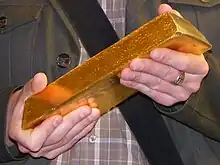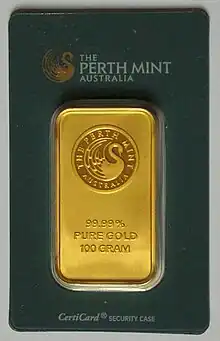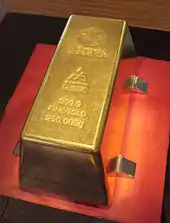
A gold bar, also called gold bullion or gold ingot, is a quantity of refined metallic gold of any shape that is made by a bar producer meeting standard conditions of manufacture, labeling, and record keeping. Larger gold bars that are produced by pouring the molten metal into molds are called ingots. Smaller bars may be manufactured by minting or stamping from appropriately rolled gold sheets. The standard gold bar held as gold reserves by central banks and traded among bullion dealers is the 400-troy-ounce (438.9-ounce; 27.4-pound; 12.4-kilogram) Good Delivery gold bar. The kilobar, which is 1,000 grams (32.15 troy ounces) in mass, and a 100 troy ounce gold bar are the bars that are more manageable and are used extensively for trading and investment.[1] The premium on these bars when traded is very low over the spot value of the gold, making it ideal for small transfers between banks and traders. Most kilobars are flat, although some investors, particularly in Europe, prefer the brick shape.[2]
Types

Based upon how they are manufactured, gold bars are categorized as having been cast or minted, with both differing in their appearance and price. Cast bars are created in a similar method to that of ingots, whereby molten gold is poured into a bar-shaped mold and left to solidify. This process often leads to malformed bars with uneven surfaces which, although imperfect, make each bar unique and easier to identify. Cast bars are also cheaper than minted bars, because they are quicker to produce and require less handling.
Minted bars are made from gold blanks that have been cut to a required dimension from a flat piece of gold. These are identified by having smooth and even surfaces.
Security features
To prevent bars from being counterfeited or stolen, manufacturers have developed ways to verify genuine bars, with the most common way being to brand bars with registered serial numbers or providing a certificate of authenticity. In a recent trend, many refineries would stamp serial numbers even on the smallest bars, and the number on the bar should match the number on its accompanying certificate.[3]
In contrast to cast bars (which are often handled directly), minted bars are generally sealed in protective packaging or tamper-evident technology to prevent tampering and keep them from becoming damaged. A hologram security feature known as a Kinegram can also be embossed directly on a gold bar. Bars that contain these are called Kinebars.[4]
 1 oz diffractive kinebar
1 oz diffractive kinebar Bar in protective casing
Bar in protective casing
Standard bar weight units

Gold is measured in troy ounces, often simply referred to as ounces when the reference to gold is evident. One troy ounce is equivalent to 31.1034768 grams. The troy ounce is heavier than the avoirdupois ounce, a commonly used unit for measuring weight in the United States customary system. One avoirdupois ounce equals 28.349523125 grams.[5]
The standard gold bar held and traded internationally by central banks and bullion dealers is the Good Delivery bar with a 400 ozt (12.4 kg; 27.4 lb) nominal weight. However, its precise gold content is permitted to vary between 350 ozt (10.9 kg; 24.0 lb) and 430 ozt (13.4 kg; 29.5 lb). The minimum purity required is 99.5% gold. These bars must be stored in recognized and secure gold bullion vaults to maintain their quality status of Good Delivery. The recorded provenance of this bar assures integrity and maximum resale value.[6]
Manufacturers
| Manufacturer | Bar sizes | |||||||||||||||||||||||||
|---|---|---|---|---|---|---|---|---|---|---|---|---|---|---|---|---|---|---|---|---|---|---|---|---|---|---|
| Grams | Ounces | Taels | Tolas | |||||||||||||||||||||||
| 1 | 2 | 2.5 | 5 | 10 | 20 | 50 | 100 | 250 | 500 | 1,000 | 1⁄10 | 1⁄4 | 1⁄2 | 1 | 2.5 | 5 | 10 | 100 | 400 | 1 | 1 | 2 | 3 | 5 | 10 | |
| Baird & Co.[7] | ||||||||||||||||||||||||||
| Emirates Gold[8] | ||||||||||||||||||||||||||
| Heraeus[9] | ||||||||||||||||||||||||||
| Metalor[10] | ||||||||||||||||||||||||||
| PAMP[11][12] | ||||||||||||||||||||||||||
| Perth Mint[13] | ||||||||||||||||||||||||||
| Royal Canadian Mint[14][15] | ||||||||||||||||||||||||||
| Royal Mint[16] | ||||||||||||||||||||||||||
| Umicore[17] | ||||||||||||||||||||||||||
| Valcambi[18][19] | ||||||||||||||||||||||||||
| UBS[20] | ||||||||||||||||||||||||||
Largest gold bar

The world's largest gold bar stands at 250 kg (8,038 ozt), measuring at the base 455 mm × 225 mm (17.9 in × 8.9 in) and 170 mm (6.7 in) high with 5 degree draft angle (equal to 15,730 cm3 or 960 cu in). It was manufactured by the Mitsubishi Materials Corporation, a subsidiary of Mitsubishi. It went on display at the Toi Gold Museum on 11 July 2005. Its gold content was valued in 2005 at 400 million yen (approximately US$3,684,000 at the time).[21][22][23] As of January 2023, it is worth approximately US$15.1 million.[24]
See also
Explanatory notes
- ↑ This is the official rate of taels in mainland China since the country implemented the metric system. In Taiwan and Hong Kong, a tael is equivalent to 37.429 g.
References
- ↑ "US and European Gold Trading".
- ↑ "What is a gold bar?". Archived from the original on 19 June 2010. Retrieved 31 July 2010.
- ↑ "Frequently Asked Questions". PAMP. Retrieved 24 April 2019.
- ↑ "KINEBARS®" (PDF). Gold Bars Worldwide. Archived (PDF) from the original on 4 March 2016. Retrieved 15 May 2017.
- ↑ Boyati, Lested (1 June 2014). "Top Recommended Gold Trading Brokers". FXdailyReport.Com. Archived from the original on 12 November 2016. Retrieved 28 October 2016.
- ↑ "Full List of Official Good Delivery Rules". lbma.org. Archived from the original on 30 March 2012. Retrieved 11 April 2012.
- ↑ "Baird & Co | Gold Bars". Baird & Co. Archived from the original on 1 December 2017. Retrieved 10 May 2017.
- ↑ "Investment Bars : Rectangular Gold Bar". Emirates Gold. Archived from the original on 19 May 2017. Retrieved 10 May 2017.
- ↑ "Gold bars". Heraeus. Archived from the original on 19 October 2016. Retrieved 10 May 2017.
- ↑ "Metalor Gold Bars". BullionByPost. Archived from the original on 23 June 2016. Retrieved 10 May 2017.
- ↑ "Cast Bars". PAMP. Archived from the original on 6 June 2017. Retrieved 10 May 2017.
- ↑ "Minted Ingots". PAMP. Archived from the original on 6 June 2017. Retrieved 10 May 2017.
- ↑ "Perth Mint Spot Prices". Perth Mint. Archived from the original on 16 April 2017. Retrieved 10 May 2017.
- ↑ "Gold Wafers | The Royal Canadian Mint". www.mint.ca. Retrieved 21 August 2019.
- ↑ "The Mint's Refinery Services | The Royal Canadian Mint". www.mint.ca. Retrieved 21 August 2019.
- ↑ "Gold Bars | Buy Gold Bars | Royal Mint Bullion". The Royal Mint. Archived from the original on 17 June 2017. Retrieved 10 May 2017.
- ↑ "Investment Bars Gold". Umicore. Archived from the original on 13 May 2017. Retrieved 10 May 2017.
- ↑ "Good Delivery Gold bar". Valcambi. Archived from the original on 10 June 2017. Retrieved 10 May 2017.
- ↑ "1 g Minted Gold bar". Valcambi. Archived from the original on 8 May 2017. Retrieved 10 May 2017.
- ↑ "UBS Gold Bars - Suisse Gold - Precious Metals Dealers".
- ↑ "Historical Exchange Rates". OANDA Services. Archived from the original on 2 February 2011. Retrieved 14 January 2010.
- ↑ "Three Diamonds Cast Gold-Medal Gold Bar". The Japan Journal. November 2005. Archived from the original on 22 July 2011. Retrieved 10 March 2010.
- ↑ "Mitsubishi makes record-size gold bar". Japan Times. 17 June 2005. Archived from the original on 31 May 2015. Retrieved 10 March 2010.
- ↑ "Gold Spot Price". GoldHub. World Gold Council. Retrieved 18 August 2020.
External links
 Media related to Gold ingots at Wikimedia Commons
Media related to Gold ingots at Wikimedia Commons